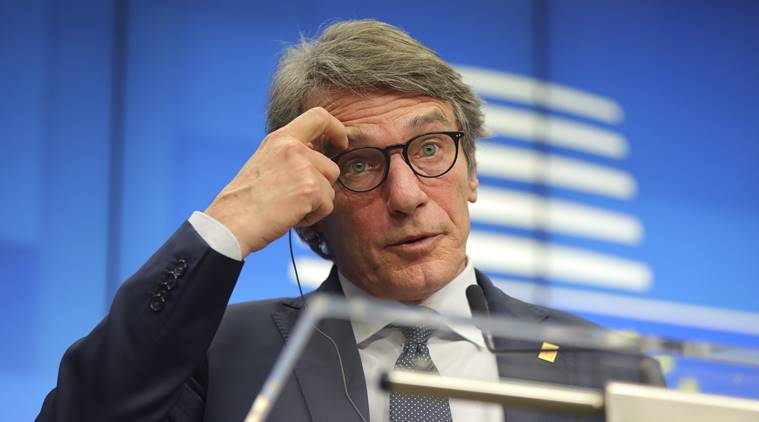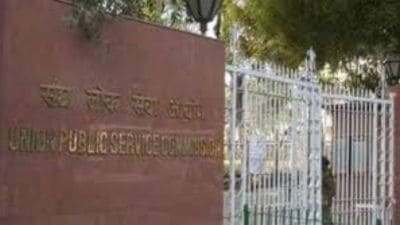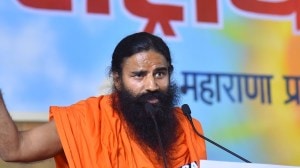- India
- International
EU’s agreement with Vietnam shows how it could reach a deal with India
The EU wants to expand its influence in Southeast Asia and counter China's growing economic, military and political clout in the region. Until now, China has been the main focus of the EU's engagement in Asia, and the Europeans are looking to diversify by strengthening their ties to other players in the region.
 European Parliament President David Sassoli speaks during a media conference at an EU summit in Brussels, Thursday, Feb. 20, 2020. (AP Photo: Olivier Matthys)
European Parliament President David Sassoli speaks during a media conference at an EU summit in Brussels, Thursday, Feb. 20, 2020. (AP Photo: Olivier Matthys)
In mid-February, the European Parliament approved a wide-ranging free trade agreement between the European Union and Vietnam, paving the way for the deal to take effect later this year.
It took both sides eight years to conclude negotiating this historic pact, which would deepen and broaden commercial ties between the fast-growing Southeast Asian nation and the world’s largest trading bloc.
The EU-Vietnam Free Trade Agreement (EVFTA) would abolish 99 per cent of customs duties, eliminate bureaucratic hurdles by aligning regulatory standards for goods like cars and medicines, and ensure easier market access for both European and Vietnamese companies.
A similar free trade agreement between the EU and India has been in the works since 2007. But a raft of disagreements has slowed down progress and negotiations, in fact, it came to a standstill between 2013 and 2018. The hurdles seemed insurmountable.
Some of the obstacles to an agreement are the EU’s demands for a stronger intellectual property regime in India and the inclusion of a sustainable development chapter with strong labor and environmental protections. The EU also views the list of sensitive items compiled by the Indian side as unacceptable.

Another area of friction is the EU’s proposal to set up an investor-state dispute settlement mechanism, which is incompatible with current Indian laws.
India, on the other hand, has its own set of demands for the EU. New Delhi wants the EU to offer Indian businesses greater market access to the bloc’s services sector. India also wants more European visas for its skilled workers. The UK has so far opposed the demand for more visas, but with Brexit this obstacle has been removed, at least in part.
The agreement between the EU and Vietnam shows how the EU and India could reach a deal. An accord would be not only in their economic interest, but also — to a minor extent — in their strategic interest.
The EU expects the agreement to give a boost to Vietnamese exports to the EU, with the annual exports likely rising by about €15 billion ($16.6 billion) by 2035.
Opinion | India and EU have accomplished much. There is more to be done
Vietnam’s export-oriented economy has relied on free trade for years. The reliance on free trade has so far worked for Vietnam, whose economy has recorded an average annual growth of 6.5% over the last five years, according to the government.
At a time when trade conflicts and national egotism are on the rise, this trade deal between the EU and Vietnam underscores the significance of free trade and a rules-based global order.
But the deal is not just about trade. There is a strategic component as well.
The EU wants to expand its influence in Southeast Asia and counter China’s growing economic, military and political clout in the region. Until now, China has been the main focus of the EU’s engagement in Asia, and the Europeans are looking to diversify by strengthening their ties to other players in the region.
And India is high up on the list of Asian countries with whom the EU seeks greater engagement. Both sides have already elevated their relations to a strategic partnership, putting ties on a firm footing.
From the EU’s perspective, issues related to labor and human rights were the main obstacles during the trade negotiations with Vietnam.
The EVFTA requires Vietnam to comply with the core international labor and environmental standards of the International Labor Organization (ILO).
Vietnam has already ratified six of the eight ILO standards. Although the freedom of assembly and the prohibition of forced labor are still missing, Vietnam’s government amended the country’s labor code in November 2019.
Starting in 2021, a new law will allow the creation of independent trade unions at the enterprise level that do not have to join Communist Party trade unions. This is a major step forward, which the authoritarian system previously refused to take. Nevertheless, it’s necessary to wait and see how this law will be implemented.
The lack of proper law enforcement in Vietnam and the nation’s poor human rights record prompted many NGOs to lobby against the EVFTA. In November 2019, 18 NGOs wrote a letter to the European Parliament calling for the ratification of the free trade agreement to be postponed until Vietnam releases all political prisoners and allows a free press.
Several NGOs have expressed disappointment at the deal’s ratification. They argue that the EU’s decision means Vietnam won’t be under any pressure to carry out reforms.
Also read | Opinion: There is so much more that India and EU can achieve together
Experience to date has shown that these assertions are not entirely baseless.
On several occasions, the EU has failed to ensure that its trade partners enforce the labor and environmental standards they agreed to as part of their free trade deals with the bloc.
South Korea, for instance, concluded an accord with the EU in 2011, but to date, only half of the deal’s core labor standards have been ratified.
Members of the European Parliament Committee on International Trade (INTA), which was responsible for the negotiations with Vietnam, have been aware of the previous shortcomings.
To counter such drawbacks, the EVFTA provides for the creation of a Domestic Advisory Group (DAG) to verify that the agreements are respected. The DAG should include representatives of employers, employees and environmental organizations.
However, in Vietnam, the question is who will sit in the DAG, and whether there will be independent NGOs and trade unions or just representatives of the ruling Communist Party.
So far, Vietnam has insisted that the terms “civil society” or “civil society organizations” do not appear in the draft text of the agreement.
There is little doubt that the deal will pass Vietnam’s national assembly and be implemented in the coming months.
The negotiations have shown that it is possible to find common ground if both parties are ready to compromise. For the deal, Vietnam had to accept certain labor rights and independent trade unions. And this will mean that the EU closely monitors the implementation and, in case of doubt, takes tough measures to ensure enforcement.
Although the political, economic and social conditions are profoundly different in Vietnam and India, two points can be made with regard to their trade negotiations with the EU: Firstly, the EU is not prepared to offer greater access to its market without reciprocal concessions, some of which are far-reaching. Secondly, the agreement with Vietnam has shown that the EU intends to strictly monitor the compliance of the deal’s terms.
If India and the EU manage to strike a deal, it could bring economic benefits not only to these two economies, but also to the entire world. In an era of rapid globalization and highly integrated value chains, such agreements give a boost to global trade and investment flows, which in turn contribute to the socioeconomic well-being of people worldwide.
The German think tank Bertelsmann and the Institute for Economic Research in 2017 published a comprehensive report about an EU-India FTA. They concluded that India’s GDP could grow by 1,3% annually if the deal becomes real.
Rodion Ebbighausen is the Managing Director (Asia) of Deutsche Welle
40 Years Ago
EXPRESS OPINION
More Explained
Apr 16: Latest News
- 01
- 02
- 03
- 04
- 05









































